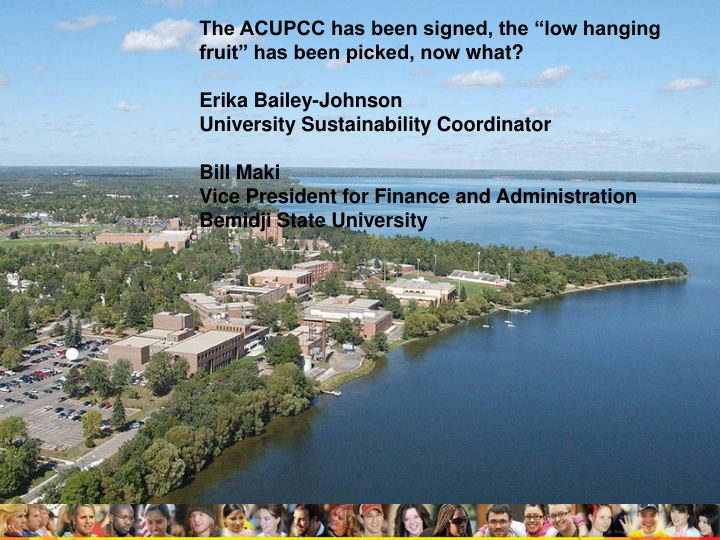



The ACUPCC has been signed, the “low hanging fruit” has been picked, now what? Erika Bailey-Johnson University Sustainability Coordinator Bill Maki Vice President for Finance and Administration Bemidji State University
Minnesota State Colleges & Universities Bemidji State University 50 mi. Enrollment – ~5,000 100 mi. 80% On-campus 1,350 live in residence halls 150 mi. Aligned with Northwest 200 mi. Technical College
History • 1992 – Dr. Duly, “Environmental Task Force ” "It is important that the University becomes more environmentally literate and sensitive. To this end, I would like to establish an Environmental Task Force to make recommendations to the University Cabinet on pertinent environmental issues." • 1996 – Dr. Benson; permanent, standing committee • 1997 – renamed “Environmental Advisory Committee” 3
History • 2004 – Environmental Stewardship proclaimed as one of three signature themes. • 2005 - Tessa Haagenson awarded National Wildlife Federation’s (NWF) Campus Ecology Fellowship Program grant. • 2005 - Sustainable Campus Endowment Fund established. • 2006 – BSU sign the Talloires Declaration. • 2008 - $5/semester green fee established by student senate. • 2008 – Sustainability Coordinator position established. • 2008 - President's Climate Change Commitment signed by President Dr. Quistgaard. • 2009 - Strategic Plan for Sustainability was developed as a roadmap for priorities up until 2013. 4
History 2010 - Consultants hired to assist with preparation of greenhouse gas (GHG) emissions inventory and Climate Action Plan (CAP). 2011 – CAP completed and accepted 2011 and forward – Continue to advise the University on pertinent environmental issues. – Facilitate and support the implementation of the CAP and the ultimate goal of carbon neutrality 5
“Low hanging fruit has been picked” • Projects with clear paybacks. and/or • Relied heavily on “ grassroot ” efforts and/or • Relied on individual champions
Projects from BSU EAC and SFE • • Replacement of incandescent bulbs Use of native plants on campus • • Purchase of hybrid vehicle for security use Addition of butterfly garden • • Installation of water-conserving shower Dorm Energy competition – “Do it in the heads and motion sensors Dark” • • Trayless policy Free Store • Purchase of wind energy
Gitigaan • Community garden • Initiated by the Geography Club and Sustainability Office • Vacant lot
Why did administration say no to or not move forward with other projects? • Concerned too much about campus aesthetics • Concerned too much about cost or payback by having a higher threshold for approval than other projects at the university • Concerned too much about perception during difficult financial times • Concerned too much about outdated policies and practices
Sattgast Fountain/Butterfly Garden • Fountain consumes energy and adds to the university’s carbon footprint. • Seven symbolic books that is part of the art project blocks the butterfly garden. • EAC involvement in process of making decisions.
Laurel House Model residence for environmentally sustainable construction practices. Honor students residence maintained.
Solar projects Solar panels to power student open computer lab. Funds from student technology fees to be used to fund project. Solar panels near our American Indian Resource Center using grant funds.
LEED certified buildings/Green construction • Last three major construction projects, totaling approximately $25 million, have not been LEED projects. • Green roof proposals have been denied because of system standards. • LEED has been an afterthought in planning and only considered if grant funding was available.
What’s Next • Integration of sustainability fully into university planning and resource allocation. • Better communication between administration and sustainability committees.
What’s Next • Campus climate activities becoming a regular agenda item at university leadership meetings. • Putting resources against priorities – “put your $$$ where your mouth is”
Thank you! 16
Recommend
More recommend